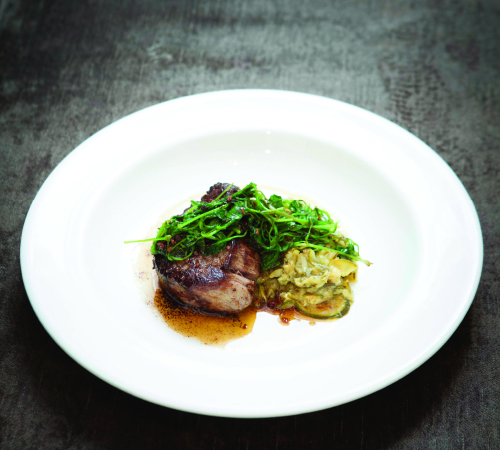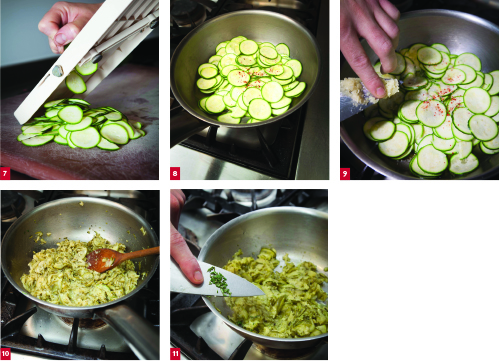Masterclass: Skye Gyngell's beef with courgettes
Skye Gyngell's beef with slow-cooked courgettes is much like its creator: refined and with impeccable taste
Since Skye Gyngell opened Spring at Somerset House in October 2014, she has been serving more than 200 covers a day and rising with an average spend of around £80.
How does she do it? Simple: her food tastes good. But why it does so is much more interesting. Many chefs source ingredients with care. They pay top dollar for meat and fish, they hire foragers to deliver rare fungi and greens and they source single-estate olive oils.
But it's at this point that Gyngell's approach diverges from her peers. Where chefs take the choicest raw materials and then refine and transform them, she lets them breathe. She has a policy of cooking dishes that can't be masked by techniques. Customers eat in a celebrity chef's restaurant to experience his or her skill and imagination. They go to Spring for a good meal.
That alone would probably guarantee success, but there is an extra dimension. Behind the simplest of recipes is 30 years of eating around the world, editing food magazines and cooking haute cuisine, as well as writing magazine articles and cookery books. It's this experience that allows her to mix and match shades of Spanish, Italian and French cuisines without them clashing.
Planning
- Trim and portion the beef fillet and slow-cook the courgettes ahead of service.
- To finish the dish to order, season, sear and rest the beef; season the slow-cooked courgettes; make the anchovy brown butter; and cook the chickweed.
Cost
Spring serves upwards of 200 covers a day with a weighting towards the evening service. The average spend hovers around £80 including beverages. Fillet of beef with brown butter sells for £32 and is costed within a menu designed to yield 70% GP.
Fillet of beef
Chefs have the option of buying whole, untrimmed fillets or ‘larder trim' with the sinew removed.
Remove the gristly chain that runs along the length of the fillet (1). Tuck your finger between it and the eye muscle to loosen it. Separate it from the fillet without cutting into the joint.
At the thick end of the fillet is a muscle (the iliacus) often referred to as the chateaubriand (2). Loosen this from the fillet proper and sever it from the joint. It's as lean and tender as the fillet itself and will yield an extra portion.
(3-4). If you use a similar technique as when skinning a fish, you'll damage the meat less and increase the yield. Trim any bits of discoloured meat on the underside of the fillet.
Portion the meat into 180g-200g steaks ahead of service (5-6). One fillet will yield about eight portions.
Slow-cooked courgettes
Spring prepares batches of slow-cooked courgettes for about 20 portions. For the photographs the kitchen worked with a quantity suitable for four portions - about 350g cooked courgettes.
Preparation is in two stages: slow cooking ahead of service and finishing to order.
Serves 4
- 500g courgettes
- 80ml light olive oil
- 5g approx crushed garlic
- Maldon salt
- 1 pinch Á±ora flakes
- 1 sprig rosemary, finely diced
- Sicilian lemon
Slice the courgettes on a Japanese mandolin (7). Pour the oil over the base of a pan that will comfortably contain the courgettes. Add the courgettes to the pan with the garlic, salt and Á±ora flakes (8-9). Mix together. Put them on the coolest part of the kitchen range so the courgettes can render down very slowly - a full batch will take 90 minutes. They are ready when they have rendered down without colouring (10). Set aside.
Finish each to order (but no more than four portions at a time, or the flavour won't be clean). Heat about 100g courgettes per serving. Dice the rosemary and add (11), along with a little lemon juice and stir. Taste and if necessary add a little extra lemon juice and salt.
Tip: Instead of buying ready prepared Á±ora flakes, buy dried chillies and blend them in a spice grinder.
There's no need to buy the smallest calibres of courgettes for this recipe, but freshness matters and so does the source. They should be grown outdoors and preferably organic.
To check for freshness, look at the cut ends. If they look dry or shrivelled, they won't be in prime condition.
Any good quality olive oil or pomace is adequate, because the aroma of an extra virgin olive oil will dissipate during the simmering.
Fillet of beef with brown butter, anchovies, chickweed and slow-cooked courgettes
Serves 1
- 20ml olive oil
- Maldon salt
- 200g fillet steak
- 2 anchovy fillets
- 50g unsalted butter, chilled
- 1tbs Volpaia red wine vinegar
- 1 handful chickweed (rocket, bitter cress, etc)
- 100g courgette [see above]
Heat the oil in a small frying pan until it's almost smoking. Sprinkle salt on both sides of the steak (12) and put it in the pan and sear on all sides - including the edges (13-15). It takes about five minutes and the surface should be well-browned all over (16). Take the meat out of the pan and rest for 10 minutes (Gyngell prefers it to be served warm rather than hot).
Wipe out the pan with kitchen paper to remove any charred or burnt traces. Finely chop the anchovies. Return the pan to the heat and add the butter, which should foam on contact with the pan (17). Heat till it turns nut brown and add the anchovy, the vinegar and lastly the chickweed (18-19).
To finish, spoon the courgette onto a very hot plate. Arrange the fillet to one side and spoon the hot butter sauce and the wilted greens on top.
Notes on the ingredients
Beef fillet
Pure Aberdeen Angus, one month dry-aged, including the chain and the chateaubriand end; approximately 2kg.
Ortiz anchovies
The ban on fishing anchovies from the Cantabrian Sea off northern Spain was lifted in 2011. The finest are filleted by hand and preserved in salt and oil. They should be smooth to the touch and have a pinkish (as opposed to brown) tinge. They will also feel meaty rather than skinny to the touch.
Volpaia vinegar (red)
This Tuscan vinegar retains the flavour of the Chianti wine from which it's made. Bacterium (the vinegar mother) is added to the wine, which is stored over oak and chestnut shavings until it ferments and turns to vinegar. It's then aged for 10 to 12 months before bottling.
Chickweed
The name gives a hint about this edible weed - chickens love it. Because the spear-shaped leaves are small, it takes foragers time to harvest a useful quantity. Herb growers also cultivate it because its tender texture and mild flavour contrast well with bitter herbs.
Sicilian lemons
Sicilians say "Lemons aren't lemons unless they come from Sicily." Their aroma is more intense and the juice packs more of a punch.
Á'ora flakes
These are from the same chillies that are used to make chorizo and xistora sausages. They have a touch of piquancy, but also a contrasting sweetness. Gyngell grinds them in this recipe.
Fern Verrow
Foraged chickweed, other wild herbs, fruit and vegetables come from Fern Verrow (www.Fernverrow.com) a 20-acre Herefordshire biodynamic farm. Spring has a contractual arrangement for it to grow and supply specific varieties of this produce when they come into season
Skye Gyngell
It would be easy to mistake Skye Gyngell for a talented home cook turned restaurateur, but this would be quite wrong. Yes, she went to Anne Willan's celebrated La Varenne cookery school fresh from university, but after that she worked full-time for a year at Dodin Bouffant, a leading nouvelle cuisine restaurant in Paris, and thence to the Dorchester when Anton Mosimann ruled the kitchens.
That professional debut might have shaped her, but it didn't, she said, because her ties to Australia and its blossoming food culture were stronger. "I fell in love with cooking because I grew up there and during the Seventies a lot of interesting things were happening. Amazing people were doing really beautiful, classical French food, and then we also had incredible immigrant communities, all of whom had their own food cultures."
Between these poles a whole movement of unstructured, creative cooking - that came to be called fusion or Pacific Rim - was evolving. "People don't talk about it any more," she says, "but I was brought up with that. When I came to London, everything was driven by high-end cooking."
Her move to the UK followed a period as editor at Australia's Vogue Entertaining. She arrived in the country armed: she knew food fashion from a media point of view and her love of informal dining was second nature. At Richmond, as Petersham Nurseries' chef-patron and figurehead, she managed a twin career that combined writing with restaurant cookery.
Spring, which she opened last year, is on another level to Petersham. It has 22 full-time staff as opposed to six at Petersham; there are two kitchens - one for preparation and a second for service -and instead of a wine list with 10 wines she has 70. She has spent, she says, 95% of her time here, working 14-hour days, six days a week.
"I'm here every day. I'm a restaurant cook (I don't even like the word chef). I love working in a team, writing menus, paying people's wages and putting bottoms on seats," she says.
















